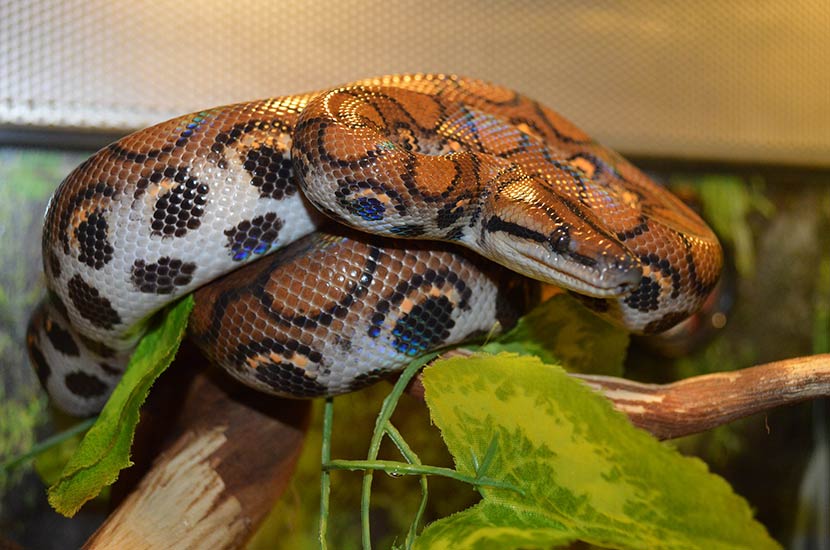Description
Perhaps one of the most stunning snakes in the reptile hobby. The iridescent sheen given off during the daylight hours is breathtaking on these nocturnal snakes. Rainbows typically grow between 3.5 and 6 feet in length and live 20-25 years with good husbandry. There are 9 different subspecies of this snake known today. This slender bodied snake is generally a maroon or light red color with brightly colored patterns surrounded by dark borders. An excellent boa for those who want the length of a big snake without the overwhelming girth.
Natural History
Rainbows are found throughout Costa Rica down through central South America. Generally, these snakes are found in the forests, grasslands, and swamps of this region both in the trees and on the ground.
Sexing
Females are generally longer than the males. Probing is an excellent way to determine gender but should be done by a confident snake keeper or veterinarian as damage to the snake can occur.
Enclosure
There are many different ways to keep Rainbow boas, as with any snake. These semi-arboreal snakes require vertical space in the cages as well as large amounts of floor space to suit their active lifestyles. Adults can be housed in Neodesha, large plastic containers, and vision cages. Vision cages are the best for monitoring, humidity support, and ample room for maneuvering. Adults can also be kept in a minimum 50 gallon tank but larger is always better with these snakes. Custom enclosures are encouraged and should be at least 4 feet long, 2 feet wide, and 2 feet high. Hatchlings and very young snakes tend to do better in smaller areas such as 10 gallon tanks or plastic shoe/sweater boxes with appropriate ventilation. Ventilation can be added to plastic enclosures via a soldering iron or a drill.
Substrate
Rainbow boas can be housed on newspaper, butcher paper, paper towel, or reptile carpet for ease of cleaning. Aspen and Care Fresh can also be used as long as the aspen is agitated daily and bedding is changed weekly. Never use pine or cedar shavings as the aromatic oils are irritating to snakes.
Temperature and Humidity
The ambient temperature in the enclosure is more consistent with what people believe to be a temperate snake than a tropical snake. The temperatures should range from 72 to 80F° with a basking spot maintained at 85F°. Any higher than 90F° and these snakes develop serious health issues and can die. These temperatures should be maintained with a thermostat and monitored with two thermometers ideally. One thermometer should be placed on the warm end an inch above the substrate and the other an inch above the substrate on the cool end of the enclosure. Under tank heaters, heat cable (outside the enclosure not in the enclosure), heat tape, and ceramic heat emitters can all be utilized to maintain air temperature.
Humidity should be maintained at 70-80% to keep this species healthy as they do poorly in low humidity. Prolonged periods of low humidity (under 50%) results in death.
Accessories
Cage accessories should consist of at least one hide box in the enclosure. Hides can be as simple as a half a flower pot, half log, or as complicated as a rock structure (make sure it’s well anchored). Branches for climbing are encouraged and necessary for this species and are wonderful for enrichment. The addition of hay or dried leaves offers new scents for the snake to explore. Also, adjusting the cage furnishings once in a while is recommended for enrichment as well.
Lighting
Rainbow boas are nocturnal by nature and do not require intense lighting despite their desert habitats. However, it is recommended that a 5.0 ReptiSun UVB bulb be offered during the daylight portion of the light cycle. All snakes can absorb the calcium from their whole prey for their own use but a UVB bulb still offers some health benefits as well as promotion of natural behaviors from the UVA being emitted.
Feeding
In the wild, these snakes feed primarily on birds, lizards, and rodents. In captivity however, most are fed mice and small rats although the largest of them have been known to eat large rats. It is highly recommended to feed only pre-killed prey as live prey can severely injure or kill a snake. Chicago Exotics recommends feeding properly thawed frozen rodents.
Young snakes are generally fed mice to small young rats every 7-10 days. Adults are fed small to large rats every 14-21 days to maintain a healthy weight. These snakes can become obese!
Sources and Recommended Reading
The Art of Keeping Snakes, Philippe De Vosjoli
Boas, Doug Wagner
The New Encyclopedia of Snakes, Christopher Mattison
Living Snakes of the World, John M. Merirtens
An educational handout concerning reptiles and Salmonella is available through the Association of Reptilian and Amphibian Veterinarians. Please ask your veterinarian for a copy.

